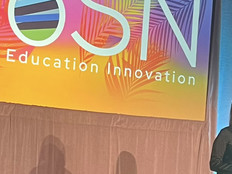The next morning, the calculus teacher just showed up at my door, and he did that almost every day or every night until I could pass the class. At that moment, I realized, “Oh, wow!” These teachers played this really important role that I just hadn’t appreciated before because I hadn’t personally needed it.
At that moment, my mind was made up. I wanted to be a teacher, and I wanted to do that for other people.
EDTECH: Educators have been going through a lot lately. Do you feel the same today, a few years into the pandemic?
CAPOSEY: Yes, 1,000 percent — I feel that way now more than ever. But if I told you there weren’t a couple of months during the pandemic that I wasn’t shaken up, I’d be lying.
EDTECH: In your TEDx Talk, you mention that when schools don’t reflect society, they become irrelevant. What role do you see technology playing in today’s schools?
CAPOSEY: It is quite literally our job to create productive citizens. If schools don’t reflect the society and the real world that students are entering, then quite frankly, we’re not doing our jobs.
When we look at the world, technology is pervasive. For years in schools, it’s like educators were fighting against that instead of embracing it. I think there’s been a dramatic shift over the past five years, accelerated by the pandemic.
But I also think that we’re changing at a linear pace, whereas society is changing at a logarithmic, exponential pace. So, we have a handful of things that we should be really cognizant of as we figure out what our next steps need to be.
DISCOVER MORE: Connected STEM classrooms break down learning silos.
EDTECH: What do you think Meridian has done to prepare students for a world where technology is the norm?
CAPOSEY: At Meridian, I think we’ve played a massive, massive game of catch-up. In terms of getting current with technology, in terms of where schools are at now, I’d say we are slightly ahead of where many other schools are at using technology, but not necessarily reflective of society either.
I think that we still have a ways to go, and it’s not necessarily about access to technology at this point. It’s about mindset when using technology.
EDTECH: You’ve said that when you started at Meridian 10 years ago, the district didn’t even have email. Where is your district now technologically, and how did you get there?
CAPOSEY: We didn’t have email or data storage when I first got there because there was a crash that was so significant, they couldn’t figure out how to repair it.
So, when I got there, we became a Google school and incrementally moved forward. Then we rewired all of our buildings to become wirelessly accessible and went one-to-one with Chromebooks. We became the first school in our region to pay our teachers to become Google-certified to deploy everything by Google Workspace for Education. So, when the pandemic hit, we were uniquely well positioned to weather that storm, because all of our teachers could do Google Classroom.
We have district-provided Wi-Fi for any student who needs it in their household, regardless of income status and whether they have demonstrated need.
It’s been incremental, year-by-year progress. I’d say the past two years, our focus has been largely on cybersecurity, to make sure that we are as safe as possible in every aspect of the technology experience, for our kids and for our district.
Click the banner to access exclusive content when you register as an Insider.












